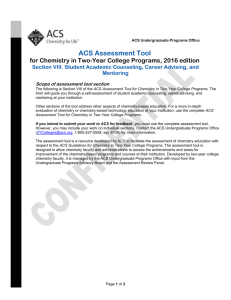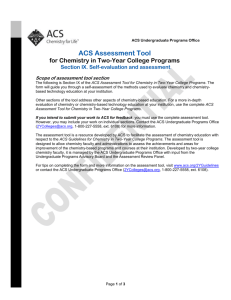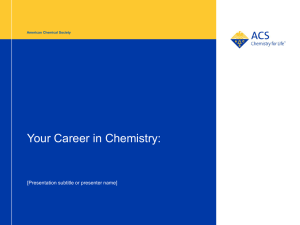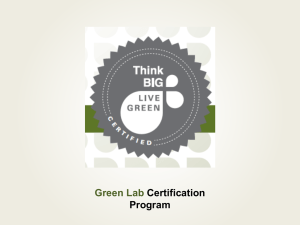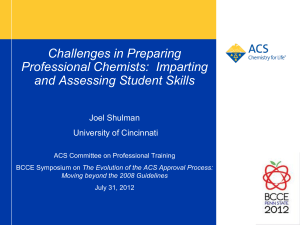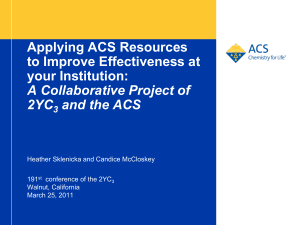X. Partnerships - American Chemical Society
advertisement
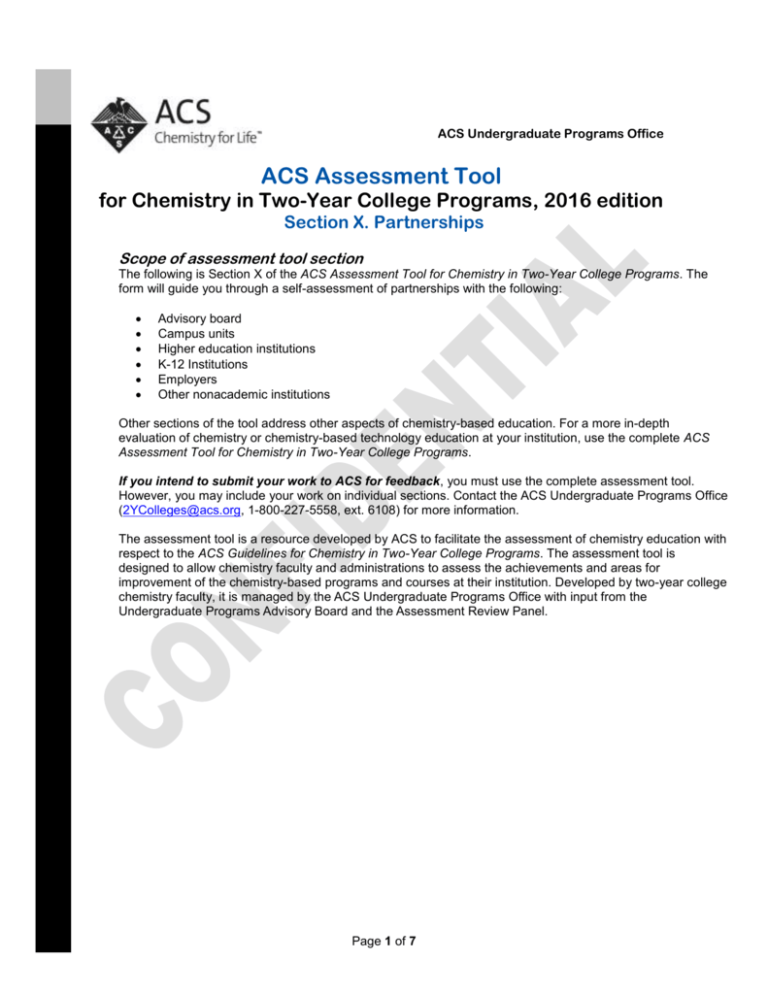
ACS Undergraduate Programs Office ACS Assessment Tool for Chemistry in Two-Year College Programs, 2016 edition Section X. Partnerships Scope of assessment tool section The following is Section X of the ACS Assessment Tool for Chemistry in Two-Year College Programs. The form will guide you through a self-assessment of partnerships with the following: Advisory board Campus units Higher education institutions K-12 Institutions Employers Other nonacademic institutions Other sections of the tool address other aspects of chemistry-based education. For a more in-depth evaluation of chemistry or chemistry-based technology education at your institution, use the complete ACS Assessment Tool for Chemistry in Two-Year College Programs. If you intend to submit your work to ACS for feedback, you must use the complete assessment tool. However, you may include your work on individual sections. Contact the ACS Undergraduate Programs Office (2YColleges@acs.org, 1-800-227-5558, ext. 6108) for more information. The assessment tool is a resource developed by ACS to facilitate the assessment of chemistry education with respect to the ACS Guidelines for Chemistry in Two-Year College Programs. The assessment tool is designed to allow chemistry faculty and administrations to assess the achievements and areas for improvement of the chemistry-based programs and courses at their institution. Developed by two-year college chemistry faculty, it is managed by the ACS Undergraduate Programs Office with input from the Undergraduate Programs Advisory Board and the Assessment Review Panel. Page 1 of 7 ACS Assessment Tool for Chemistry in Two-Year College Programs, 2016 edition X. Partnerships A. Advisory board (See Section 10.1 of the ACS Guidelines for Chemistry in Two-Year College Programs, p. 33.) 1. Does the chemistry or chemistry-based technology program or department have a formal advisory board or other type of advising group? ☐ Yes ☐ No 2. Which of the following stakeholders are represented in the advisory board? Internal stakeholders External stakeholders ☐ Program faculty ☐ Employers ☐ Program administration ☐ Other two-year colleges ☐ Faculty and/or administration from allied programs ☐ Current and/or former students ☐ Four-year institutions ☐ K-12 institutions ☐ Other (specify: Click here to enter text.) ☐ Workforce development agencies ☐ Other (specify: Click here to enter text.) 3. What is the approximate frequency of the following interactions? Face-to-face meetings: Choose an item. Online meetings or conference calls: Choose an item. Email or social media communication: Choose an item. 4. Rate the effectiveness of the board in carrying out its responsibilities. Curriculum development Curriculum maintenance Curriculum alignment with needs of receiving organizations Infrastructure support Provision of experiential opportunities, such as research and/or internships Student recruitment Student articulation Graduate placement Other (specify): Click here to enter text. Other (specify): Click here to enter text. Other (specify): Click here to enter text. 5. Provide any additional comments on the advisory board. Click here to enter text. Page 2 of 7 Choose an item. Choose an item. Choose an item. Choose an item. Choose an item. Choose an item. Choose an item. Choose an item. Choose an item. Choose an item. Choose an item. ACS Assessment Tool for Chemistry in Two-Year College Programs, 2016 edition Section X. Partnerships B. Campus units (See Section 10.2 of the ACS Guidelines for Chemistry in Two-Year College Programs, p. 33-34.) 1. Describe the frequency and types of collaborations between chemistry and/or chemistry-based technology faculty and the following campus units. ☐ Chemistry or chemistry-based technology faculty do not collaborate with other campus units. Campus unit Frequency Discussions or activities Staff providing student support services Choose an item. Click here to enter text. Advisors and counselors Choose an item. Click here to enter text. Faculty or administration in allied programs Choose an item. Click here to enter text. (specify programs): Click here to enter text. Faculty or administration in other campus programs (specify programs): Click here to Choose an item. Click here to enter text. enter text. Other campus units (specify): Click here to Choose an item. Click here to enter text. enter text. 2. Describe any collaborative activities that take place with other campus units. Click here to enter text. 3. Provide any additional comments on partnerships and collaborations with other campus units. Click here to enter text. C. Higher education institutions (See Section 10.3 of the ACS Guidelines for Chemistry in Two-Year College Programs, p. 34-35.) 1. Describe the frequency and types of collaborations between your chemistry or chemistrybased technology faculty and their counterparts at local four-year institutions. ☐ Our college is not engaged in any partnership activities with any four-year institutions Type of activity Frequency Description Collaborative research Choose an item. Click here to enter text. Other collaborative projects Choose an item. Click here to enter text. Group meetings Articulation discussions, conferences, or workshops Support for student transfer Student outreach Expansion of program offerings Curriculum alignment Sharing resources Other activities (specify): Click here to enter text. Choose an item. Click here to enter text. Choose an item. Click here to enter text. Choose an item. Choose an item. Choose an item. Choose an item. Choose an item. Click here to enter text. Click here to enter text. Click here to enter text. Click here to enter text. Click here to enter text. Choose an item. Click here to enter text. Page 3 of 7 ACS Assessment Tool for Chemistry in Two-Year College Programs, 2016 edition Section X. Partnerships 2. What is the impact of these interactions on the following outcomes? None Slight Improved student articulation ☐ ☐ Comments: Click here to enter text. Expansion of program offerings ☐ ☐ Comments: Click here to enter text. Improved student preparedness for college Comments: Click here to enter text. Improved student interest in the sciences Comments: Click here to enter text. Improved student success Comments: Click here to enter text. Other outcomes (specify): Click here to enter text. Comments: Click here to enter text. Moderate ☐ Strong ☐ N/A ☐ ☐ ☐ ☐ ☐ ☐ ☐ ☐ ☐ ☐ ☐ ☐ ☐ ☐ ☐ ☐ ☐ ☐ ☐ ☐ ☐ ☐ ☐ ☐ 3. Describe the frequency and types of collaborations chemistry or chemistry-based technology faculty with their counterparts at local two-year institutions. ☐ Our college is not engaged in any partnership activities with any other two-year colleges Type of activity Frequency Description Collaborative research Choose an item. Click here to enter text. Other collaborative projects Choose an item. Click here to enter text. Group meetings Articulation discussions, conferences, or workshops Support for student transfer Student outreach Expansion of program offerings Curriculum alignment Sharing resources Other activities (specify): Click here to enter text. Choose an item. Click here to enter text. Choose an item. Click here to enter text. Choose an item. Choose an item. Choose an item. Choose an item. Choose an item. Click here to enter text. Click here to enter text. Click here to enter text. Click here to enter text. Click here to enter text. Choose an item. Click here to enter text. 4. Briefly describe any additional activities or outcomes resulting from collaboration with local two- and four-year institutions. Click here to enter text. Page 4 of 7 ACS Assessment Tool for Chemistry in Two-Year College Programs, 2016 edition Section X. Partnerships D. K-12 Institutions (See Section 10.4 of the ACS Guidelines for Chemistry in Two-Year College Programs, p. 35.) 1. Describe the frequency and types of collaborations between chemistry or chemistry-based technology faculty and high schools and/or K-12 institutions. ☐ Our college is not engaged in any partnership activities with any K-12 institutions. Type of activity Frequency Description Student outreach Choose an item. Click here to enter text. Student recruitment Choose an item. Click here to enter text. Curriculum alignment Choose an item. Click here to enter text. Sharing resources Choose an item. Click here to enter text. Dual enrollment courses Choose an item. Click here to enter text. Professional development for in-service Choose an item. Click here to enter text. teachers Preparation for future educators Choose an item. Click here to enter text. Other activities (specify): Click here to enter Choose an item. Click here to enter text. text. 2. What is the impact of these interactions on the following outcomes? None Slight Improved science learning at high schools/K-12 ☐ ☐ institutions Comments: Click here to enter text. Improved student recruitment ☐ ☐ Comments: Click here to enter text. Improved student preparedness for college Comments: Click here to enter text. Improved student interest in the sciences Comments: Click here to enter text. Improved student success Comments: Click here to enter text. Other outcomes (specify): Click here to enter text. Comments: Click here to enter text. Moderate Strong N/A ☐ ☐ ☐ ☐ ☐ ☐ ☐ ☐ ☐ ☐ ☐ ☐ ☐ ☐ ☐ ☐ ☐ ☐ ☐ ☐ ☐ ☐ ☐ ☐ ☐ ☐ 3. Briefly describe any additional activities and/or outcomes resulting from collaboration with local high schools and K-12 institutions. Click here to enter text. Page 5 of 7 ACS Assessment Tool for Chemistry in Two-Year College Programs, 2016 edition Section X. Partnerships E. Employers (See Section 10.5 of the ACS Guidelines for Chemistry in Two-Year College Programs, p. 35-36.) 1. Describe the frequency and types of collaborations between chemistry or chemistry-based technology faculty and employers. ☐ Our college is not engaged in any partnership activities with any employers Type of activity Frequency Description Curriculum alignment Choose an item. Click here to enter text. Graduation/employment projections Choose an item. Click here to enter text. Resource-sharing Choose an item. Click here to enter text. Student recruitment Choose an item. Click here to enter text. Student internships and other experiential Choose an item. Click here to enter text. opportunities Lab tours Choose an item. Click here to enter text. Guest speakers Choose an item. Click here to enter text. Faculty professional development Choose an item. Click here to enter text. Continuing education for incumbent Choose an item. Click here to enter text. employees Other activities (specify): Click here to enter Choose an item. Click here to enter text. text. 2. What is the impact of these interactions on the following outcomes? None Slight Improved student recruitment ☐ ☐ Comments: Click here to enter text. Improved student learning ☐ ☐ Comments: Click here to enter text. Improved student retention and graduation rates Comments: Click here to enter text. Improved graduate placement rates Comments: Click here to enter text. Reduced hiring and training costs for employers Comments: Click here to enter text. Other outcomes (specify): Click here to enter text. Comments: Click here to enter text. Moderate ☐ Strong ☐ N/A ☐ ☐ ☐ ☐ ☐ ☐ ☐ ☐ ☐ ☐ ☐ ☐ ☐ ☐ ☐ ☐ ☐ ☐ ☐ ☐ ☐ ☐ ☐ ☐ 3. Briefly describe any additional activities or outcomes resulting from collaboration with local employers. Click here to enter text. Page 6 of 7 ACS Assessment Tool for Chemistry in Two-Year College Programs, 2016 edition Section X. Partnerships F. Other nonacademic institutions (See Section 10.6 of the ACS Guidelines for Chemistry in Two-Year College Programs, p. 36.) 1. Describe the frequency and types of collaborations between chemistry or chemistry-based technology and any organizations not fitting the above categories. Click here to enter text. 2. What is the impact of these interactions on your school and your partners? Click here to enter text. 3. Provide any additional comments on partnerships and collaborations with other organizations. Click here to enter text. Page 7 of 7
